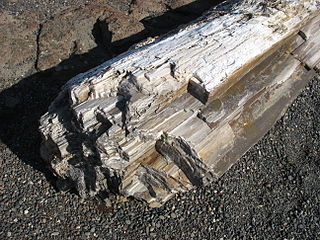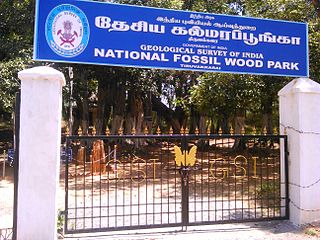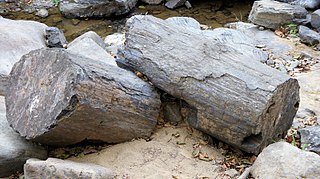
The Thar Desert, also known as the Great Indian Desert, is an arid region in the north-western part of the Indian subcontinent that covers an area of 200,000 km2 (77,000 sq mi) in India and Pakistan. It is the world's 18th-largest desert, and the world's 9th-largest hot subtropical desert.

Petrified wood, also known as petrified tree, is the name given to a special type of fossilized wood, the fossilized remains of terrestrial vegetation. Petrifaction is the result of a tree or tree-like plants having been replaced by stone via a mineralization process that often includes permineralization and replacement. The organic materials making up cell walls have been replicated with minerals. In some instances, the original structure of the stem tissue may be partially retained. Unlike other plant fossils, which are typically impressions or compressions, petrified wood is a three-dimensional representation of the original organic material.
Desert National Park is a national park in the Indian state of Rajasthan, near the towns of Jaisalmer and Barmer. It is one of the largest national parks, covering an area of 3,162 km2 (1,221 sq mi) in the Thar Desert. Sand dunes form around 44% of the park. The major landform consists of craggy rocks and compact salt lake bottoms, intermedial areas and fixed dunes. It was gazetted in 1980.

Archaeopteris is an extinct genus of progymnosperm tree with fern-like leaves. A useful index fossil, this tree is found in strata dating from the Upper Devonian to Lower Carboniferous, the oldest fossils being 385 million years old, and had global distribution.

Araucarioxylon arizonicum is an extinct species of conifer that is the state fossil of Arizona. The species is known from massive tree trunks that weather out of the Chinle Formation in desert badlands of northern Arizona and adjacent New Mexico, most notably in the 378.51 square kilometres Petrified Forest National Park. There, these trunks are locally so abundant that they have been used as building materials.

Ginkgo Petrified Forest State Park/Wanapum Recreational Area is a geologic preserve and public recreation area covering 7,124-acre (2,883 ha) on the western shoreline of the Columbia River's Wanapum Reservoir at Vantage, Washington. Petrified wood was discovered in the region in the early 1930s, which led to creation of the state park as a national historic preserve. Over 50 species are found petrified at the site, including ginkgo, sweetgum, redwood, Douglas-fir, walnut, spruce, elm, maple, horse chestnut, cottonwood, magnolia, madrone, sassafras, yew, and witch hazel.

Jaisalmer district is the largest district in the Indian state of Rajasthan, and the third largest district in India. Located in Marwar, the city of Jaisalmer is the administrative headquarters of the district. It is around 289 km (180 mi) from the city of Jodhpur, and around 559 km (347 mi) from Jaipur, the capital of Rajasthan. As of the 2011 population census, it is the least populous district out of all 33 districts in Rajasthan.

The Lesvos Petrified Forest is a petrified wood forest on the island of Lesbos, Greece.
Tindivanam is a town and a municipality in Viluppuram district in the Indian state of Tamil Nadu. It is the second largest town in Villupuram District after the headquarters town Villupuram. Important roads from north to south Tamil Nadu pass through Tindivanam and similarly from west to east.
The Geological Survey of India (GSI) currently maintains two protected areas bearing rich fossil deposits.

The Gallatin Range is a mountain range of the Rocky Mountains, located in the U.S. states of Montana and Wyoming. It includes more than 10 mountains over 10,000 feet (3,000 m). The highest peak in the range is Electric Peak at 10,969 feet (3,343 m).

The National Fossil Wood Park, Tiruvakkarai is a notified National Geo-heritage Monument located in the Villupuram District in the Indian state of Tamil Nadu and is maintained by the Geological Survey of India. The park was established in 1940 and is located 1 km east of Thiruvakkarai village on the road between Tindivanam and Pondicherry.

Specimen Ridge, el. 8,379 feet (2,554 m) is an approximately 8.5-mile (13.7 km) ridge along the south rim of the Lamar Valley in Yellowstone National Park. The ridge separates the Lamar Valley from Mirror Plateau. The ridge is oriented northwest to southeast from the Tower Junction area to Amethyst Mountain. The ridge is known for its abundance of amethyst, opal and petrified wood. It was referred to as Specimen Mountain by local miners and was probably named by prospectors well before 1870. The south side of the ridge is traversed by the 18.8-mile (30.3 km) Specimen Ridge Trail between Tower Junction and Soda Butte Creek. The trail passes through the Petrified Forest and over the summit of Amethyst Mountain el. 9,614 feet (2,930 m).

National Fossil Wood Park, Sathanur is a National Geo-heritage Monument of India located at Sathanur in Perambalur district, Tamil Nadu. This park is located within Sathanur panchayat and has a fossilized tree trunk, which was discovered in 1940 by the geologist M. S. Krishnan of the Geological Survey of India, who hailed from Tanjore.
Amethyst Mountain, el. 9,609 feet (2,929 m) is the highest peak and central part of a northwest – southeast trending ridge that lies between the Lamar River to the northeast and Deep Creek to the southwest within Park County, Wyoming. From northwest to southeast, this ridge consists of Specimen Ridge, Amethyst Mountain, and the Mirror Plateau in Yellowstone National Park. The nearest town is Silver Gate, Montana, which is 19.2 miles away.

Kuldhara is an abandoned village in the Jaisalmer district of Rajasthan, India. Established around the 13th century, it was once a prosperous village inhabited by Paliwal Brahmins. It was abandoned by the early 19th century for unknown reasons, possibly because of dwindling water supply, an earthquake, or as a local legend claims, because of the atrocities by the Jaisalmer State's minister Salim Singh.

Puyango Petrified Forest is a fossil deposit of petrified wood located in the middle basin of the Puyango River, between the Ecuadorian provinces of El Oro and Loja. The area covers 2,658 hectares and its sediments are divided into four geological formations, dating from the late Cretaceous period. These deposits are rich in both fossilized trunks and leaves - which belonged to the typical Mesozoic flora - as well as fossils of invertebrates such as bivalves, ammonites, echinoderms, among others.

Rooparam Dhandev is an Indian politician from Rajasthan. He is elected Member of 15th Rajasthan Legislative Assembly from Jaisalmer constituency in Rajasthan. He was ex-Chief Engineer from PHED in Rajasthan. He is an Indian National Congress politician in Rajasthan.
Rajkumari Ratnavati Girls School is a girls school in the rural thar desert of Jaisalmer in indian state of Rajasthan. The school is unique in that the architects designed it in the shape of an oval that can withstand temperatures of up to 50 degrees Celsius. The school can accommodate 400 girls from kindergarten to tenth grade. The school is aimed to provide education and training in traditional skill sets such as artistry, weaving, embroidery for women. Rajkumari Ratnavati Girls School is designed by a New York based company Diana Kellogg Architects. It is on the boundary of Desert National Park, and Sam lies close by in the west which is the location of sand dune safaris and resorts.
Sam is city and Tehsil in Jaisalmer district in Rajasthan. It is situated 45 km away from district headquarter Jaisalmer.














